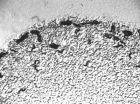(Press-News.org) PASADENA, Calif.— Scientists have long seen evidence of social behavior among many species of animals, both on the earth and in the sea. Dolphins frolic together, lions live in packs, and hornets construct nests that can house a large number of the insects. And, right under our feet, it appears that nematodes—also known as roundworms—are having their own little gatherings in the soil. Until recently, it was unknown how the worms communicate to one another when it's time to come together. Now, however, researchers from the California Institute of Technology (Caltech) and the Boyce Thompson Institute at Cornell University have identified, for the first time, the chemical signals that promote aggregation.
"We now have an expanded view of a very fundamental type of communication, which is recognizing other members of the same species and getting together with them," says Jagan Srinivasan, a senior research fellow in biology at Caltech and lead author of the study detailing this process, which was published in the January issue of PLoS Biology.
The researchers looked at the lab-friendly Caenorhabditis elegans worm—a relatively safe version of the phylum, whose parasitic cousins include hookworms, whipworms, and trichinas, which cause trichinosis—to gather data.
According to Paul Sternberg, Thomas Hunt Morgan Professor of Biology at Caltech and a corresponding author on the paper, nearly 25 percent of the world's human population is infected with some type of parasitic nematode; animals and plants can fall prey to the nasty worms, too. Since nematode parasites live inside a host and attack it internally, knowing how the worms communicate via chemicals could be very important to the fields of biomedicine and agriculture.
"One of the ways to eradicate them would be to have some sort of a chemical that can attract them in order to kill them more efficiently," explains Srinivasan.
Sternberg and Srinivasan are not new to the idea of chemical signaling among C. elegans. In 2008, their research showed how the worms secrete chemicals as a sexual attractant. This time, they worked to find chemical cues that control the social behavior of aggregation. What they found is a complex "language," in which the worms combine different chemicals into compounds, building a molecular library of signals that regulate behavior. They did this by testing a previously identified family of chemicals in mutant worms—made to not produce the chemicals on their own—to measure the behavioral effects of the different chemical combinations.
"We're starting to get a hold on the chemical 'alphabet' that makes up these words, which have different meanings in different social contexts," says Srinivasan. "It's a modular code that tells us that within the physiology of the organism, there is a lot going on in terms of how the environment is interpreted and read out for social communication."
For example, one class of chemicals the researchers found encourages worm-to-worm company, while a different class of compounds being expressed at the same time keeps other worms away. This suggests that the worms release different amounts of each compound based on what each worm is trying to communicate. If the worm is starting a new colony, it probably just wants a certain number of worms around to find and share food—too many and the colony may not thrive. However, if there is a big piece of fruit, the worm may call on a large group to help access the food source.
"The amazing thing here is that for one chemical, if it's modified even just a little bit, the meaning is changed," says Sternberg, who is also an investigator with the Howard Hughes Medical Institute. "That's what makes it more like a language. If I say a Chinese word, and my intonation is wrong, the word has a different meaning."
Next, the team will explore whether or not the same chemical compounds are made by other nematodes. They will also work to figure out how the worms' nervous system senses and sorts the different compounds.
"Understanding the worm's language is just a first step," says Srinivasan. "We hope that by learning more about how social recognition occurs in the worm nervous system, we can eventually provide insights into how the human brain encodes social information, too."
INFORMATION:
The study, "A Modular Library of Small Molecule Signals Regulates Social Behaviors in Caenorhabditis elegans," was funded by the National Institutes of Health and the Howard Hughes Medical Institute. Other members of Sternberg's lab who contributed to the study were postdoc Alon Zaslaver and graduate student Margaret C. Ho. Cornell researchers Stephen H. von Reuss, Neelanjan Bose, Parag Mahanti, Oran G. O'Doherty, and Frank Schroeder, along with Arthur Edison of the University of Gainesville in Florida, were also coauthors on the paper.
Worm seeks worm: Caltech researchers find chemical cues driving aggregation in nematodes
2012-01-13
ELSE PRESS RELEASES FROM THIS DATE:
Discovery could help stem smoking-related diseases
2012-01-13
Sufferers of smoking related lung diseases could have their debilitating symptoms reduced following the discovery of a potential new treatment.
The discovery, by researchers at the University of Melbourne, Royal Melbourne Hospital, Australia, and the Brigham and Women's Hospital, Harvard Medical School, US, could dramatically improve treatments and slow the progression of COPD (Chronic Obstructive Pulmonary Disease) which includes the incurable condition emphysema.
COPD is a progressive disease that makes it hard to breathe and is mostly caused by excessive smoking. ...
Grapes may help prevent age-related blindness
2012-01-13
FRESNO, Calif. – Can eating grapes slow or help prevent the onset of age-related macular degeneration (AMD), a debilitating condition affecting millions of elderly people worldwide? Results from a new study published in Free Radical Biology and Medicine suggest this might be the case. The antioxidant actions of grapes are believed to be responsible for these protective effects.
The study compared the impact of an antioxidant-rich diet on vision using mice prone to developing retinal damage in old age in much the same way as humans do. Mice either received a grape-enriched ...
In tackling lead pollution, fungi may be our friends
2012-01-13
Fungi may be unexpected allies in our efforts to keep hazardous lead under control. That's based on the unexpected discovery that fungi can transform lead into its most stable mineral form. The findings reported online on January 12 in Current Biology, a Cell Press publication, suggest that this interaction between fungi and lead may be occurring in nature anywhere the two are found together. It also suggests that the introduction or encouragement of fungi may be a useful treatment strategy for lead-polluted sites.
"Lead is usually regarded as a pretty stable substance," ...
Boston College researchers locate protein that could 'turn off' deadly disease carrier
2012-01-13
CHESTNUT HILL, MA (Jan. 12, 2012) – Researchers from Boston College have discovered a protein that plays a pivotal role in the progression of the deadly diseases toxoplasmosis and malaria and shown that its function could be genetically blocked in order to halt the progress of the parasite-borne illnesses, the team reports in the current edition of the journal Science.
The protein, identified as DOC2.1, plays a similar role in the secretion of microneme organelles that are crucial to the mobility of the parasitic protozoa Toxoplasma gondii, which causes toxoplasmosis, ...
Diverse ecosystems are crucial climate change buffer
2012-01-13
Preserving diverse plant life will be crucial to buffer the negative effects of climate change and desertification in in the world's drylands, according to a new landmark study.
The findings of the multi-author study, published today in the journal Science, are based on samples of ecosystems in every continent except Antarctica.
They confirm for the first time that the more diverse an ecosystem is, the more ecological functions it performs. It also has implications for carbon sequestration and soil health.
"This is the most extensive study of the links between function ...
Conserving biodiversity could benefit the world's poor
2012-01-13
Land areas that are a priority for wildlife conservation provide relatively high levels of ecosystem services such as pollination, water purification, food production, and climate regulation, so safeguarding them is expected to benefit people. Assessing these benefits to populations in ways that are useful to decisionmakers who guide conservation efforts has, however, proved difficult.
A global analysis published in the January 2012 issue of BioScience by Will R. Turner of Conservation International and his colleagues breaks new ground by analyzing the flow of benefits ...
Scientists confirm tobacco use by ancient Mayans
2012-01-13
Archaeologists examining late period Mayan containers have identified nicotine traces from a codex-style flask, revealing the first physical evidence of tobacco use by ancient Mayans. The study published in Rapid Communications in Mass Spectrometry reveals the flask is marked with Mayan hieroglyphics reading, "y-otoot 'u-may," ("the home of its/his/her tobacco,") making it only the second case to confirm that the text on the exterior of a Mayan vessel corresponds to its ancient use.
"Investigation of food items consumed by ancient people offers insight into the traditions ...
The world's smallest magnetic data storage unit
2012-01-13
Scientists from IBM and the German Center for Free-Electron Laser Science (CFEL) have built the world's smallest magnetic data storage unit. It uses just twelve atoms per bit, the basic unit of information, and squeezes a whole byte (8 bit) into as few as 96 atoms. A modern hard drive, for comparison, still needs more than half a billion atoms per byte. The team present their work in the weekly journal Science this Friday (13 January 2012). CFEL is a joint venture of the research centre Deutsches Elektronen-Synchrotron DESY in Hamburg, the Max-Planck-Society (MPG) and the ...
Don't know much about charter schools
2012-01-13
Some two decades into the grand national experiment with charter schools, how much do we really know about them? Not all that much. And not nearly as much as we easily could, say researchers from the University of California, San Diego Division of Social Sciences.
Writing in the journal Science, UC San Diego educational economist JuIian Betts and Richard Atkinson, president emeritus of the University of California and former director of the National Science Foundation, find that most studies of charter schools "use unsophisticated methods that tell us little about causal ...
Researchers discover particle which could 'cool the planet'
2012-01-13
In a breakthrough paper published in Science, researchers from The University of Manchester, The University of Bristol and Sandia National Laboratories report the potentially revolutionary effects of Criegee biradicals.
These invisible chemical intermediates are powerful oxidisers of pollutants such as nitrogen dioxide and sulfur dioxide, produced by combustion, and can naturally clean up the atmosphere.
Although these chemical intermediates were hypothesised in the 1950s, it is only now that they have been detected.
Scientists now believe that, with further research, ...

